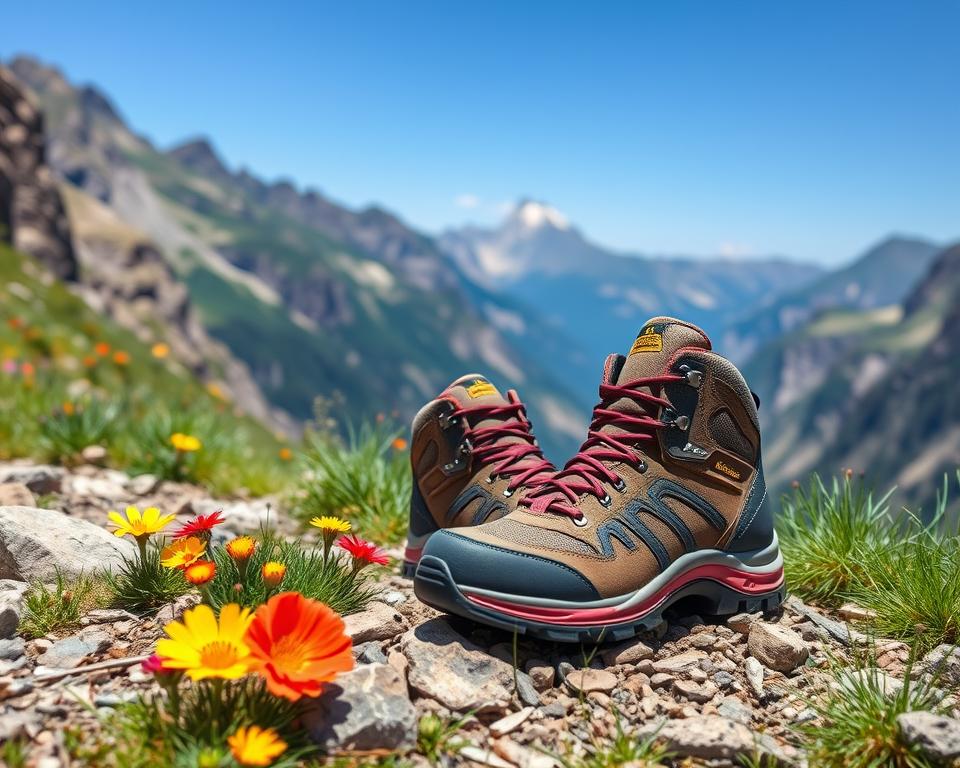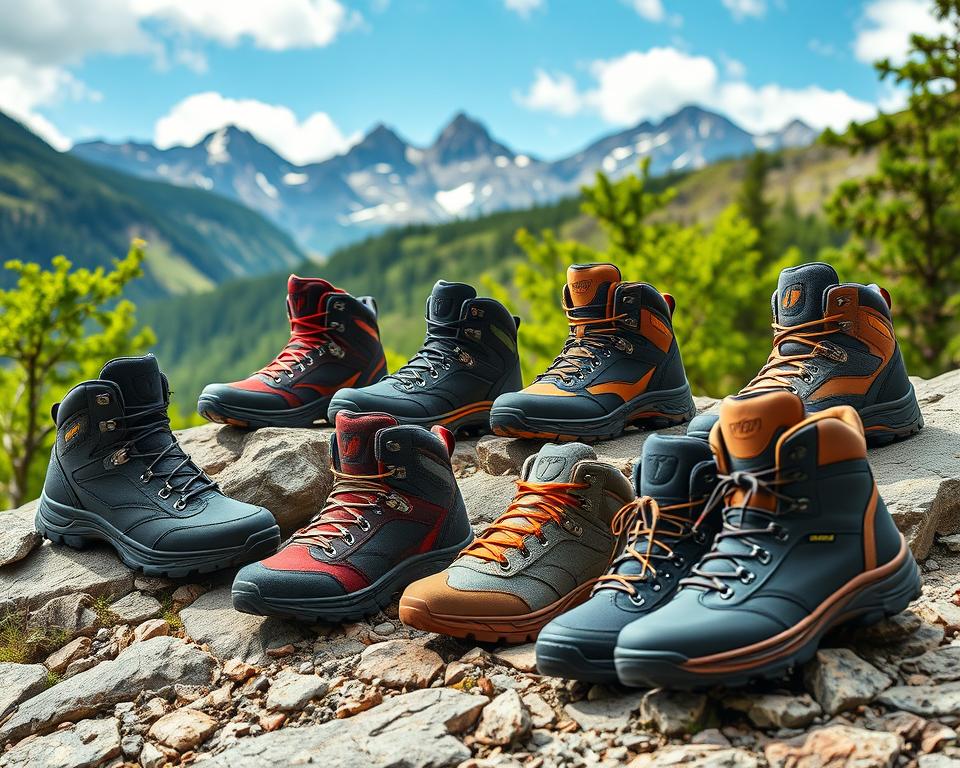Choosing the right hiking boots is crucial for your outdoor adventure. They must fit your foot type, your pack’s weight, and the terrain. There isn’t a universal solution; ideal hiking boots feel like part of you, offering stability, support, and comfort.
I picked the Merrell Moab2 Ventilators for a tough hike in Southwest Tasmania. Their light design and breathability were perfect for the area’s changing weather and rough paths. Whether you need light, mid, or heavy boots, there’s a type that fits your journey.
Finding the right hiking boots is about matching them to your style and needs. Explore this guide to discover the best boots for your adventures. Let’s make your next trip unforgettable.
Understanding Different Types of Hiking Boots
Exploring hiking boots shows they’re not all the same. Your hiking style, the ground you’ll walk on, and your experience shape your choice. There are many types of boots for your adventures.
Lightweight Hikers
Light boots are great for those who love moving fast and smoothly. Made mainly from synthetics, they’re ideal for easy to medium paths. They suit backpackers who can handle less support because they’re lighter. The Merrell Moab Speed boots are a favorite. They weigh just 11.28oz each, blending lightness and strength.
Midweight Hikers
Midweight boots offer a balance. They provide better ankle support and are good for heavier packs on uneven ground. Their design focuses on both support and keeping weight down. The Merrell Rogue Hiker Mid Goretex boots, at 14.5oz each, are an example. They offer comfort and durability without being too heavy.
Heavyweight Hikers
For extreme conditions, go for heavyweight boots. Made of tough leather, they withstand the toughest environments. They are waterproof, durable, and supportive, ideal for heavy loads and rough paths. Despite lighter trends, the Moab 3 Mid Waterproof boots, at 16.36oz each, are reliable. They remain popular for their strength.
Think about the ankle support and foot support you need. Also, consider the weight of your gear and the trails you’ll explore. Thanks to new technology and materials, there’s a perfect pair of boots for every hiker.
The Importance of Fit and Comfort
Having the right fit and comfort in your hiking boots is key. A good fit prevents blisters and foot problems. So, it’s crucial to measure your feet accurately before buying boots.
How to Measure Your Feet
You can easily measure your feet at home. Here’s a simple method I recommend:
- Place a piece of paper on a hard floor.
- Stand on the paper, ensuring the full weight is on your foot.
- Trace the outline of the foot with a pen held perpendicular to the paper.
- Measure the length and width of the tracing using a ruler.
- Compare the measurements with the sizing chart of the boot manufacturer.
It’s important to measure both feet. Often, one foot is a bit larger than the other.

Tips for Ensuring a Proper Fit
Finding the proper fit for hiking boots is key for comfort. Here are some tips that are really helpful:
- Try on boots later in the day when your feet have naturally swollen.
- Always wear your hiking socks to get the most accurate fit.
- Walk around in the store for a bit to gauge comfort and support.
- Consider using insoles if the boots feel too loose in specific areas.
- Pay attention to how the boots feel with the added weight of your hiking pack.
A good fit for hiking boots should be snug but not too tight. Your toes should have room to wiggle. Keep these tips in mind, and you will find the perfect boots for your adventures.
How to choose hiking boots
Choosing the right hiking boots may seem hard, but it’s about knowing what you need. It’s key to think about the terrain and your hiking style. Rugged trails demand durable boots from brands like Keen, Merrell, or Salomon for great ankle support.
First, figure out your hiking style. Are you walking on easy paths or rough terrain? For light, flexible shoes, day hiking options work well. They might not support ankles well for long walks. Day hiking boots, however, offer more stability for longer adventures. For tougher trails, consider backpacking boots from Scarpa or Zamberlan for the best support and toughness.
It’s important to know the pros and cons of trail footwear. Backpacking boots are supportive but heavy. This can make you tired on long hikes. Trail running shoes, on the other hand, are light and flexible. They’re great for fast hiking but might not support your ankles as well.
Material matters too. Full-grain leather lasts long and keeps water out but takes time to soften. Synthetic boots, like those from Oboz or Columbia, are light and cool but may not last as long on harsh terrain. Special features like toe caps and tongue designs also help keep feet safe and comfortable.
Getting the right fit is crucial. Always try boots with the socks you’ll hike in. Brands fit differently, so consider your foot shape. Make sure there’s space for your toes, especially on downhill paths. Wear your new boots on short walks to break them in. This way, you’ll get the support, comfort, and durability you need for your hikes.
How Do the Right Hiking Boots Complement the Use of Hiking Poles for Different Terrains?
Choosing hiking poles can greatly enhance your stability and support on rugged trails. However, the right hiking boots complement this equipment perfectly. They provide essential grip and comfort, allowing for confident strides over varying terrains. Together, they create a harmonious setup for a smoother and safer hiking experience.
Material Matters: Leather vs. Synthetic
Choosing hiking boots often involves a debate: full-grain leather or synthetic materials. Both offer unique benefits and downsides, impacting your hiking experience. Knowing these differences is key to picking boots that match your hiking needs and style.
Advantages of Full-Grain Leather
The Merrell Moab 3 Mid Waterproof boots, made of full-grain leather, are known for their durability. They handle rough terrains well and keep water out. These boots are a top choice for serious hikers. The Merrell Moab 3, weighing 2 lbs, 4 oz, offers a good mix of durability and comfort. But, remember, leather boots need time to break in and may dry slowly after getting wet. This can affect breathability during long hikes.
Benefits of Synthetic Materials
Synthetic boots, like the Salomon X Ultra 4 Mid GTX, dry quickly and let your feet breathe. They are light, at 1 lb, 14.4 oz, making them perfect for summer or wet conditions. These materials also require little time to break in. This means you can enjoy the trails with less foot discomfort. The Arc’teryx Bora Mid GTX® Boot shows how synthetic boots support backpacking. They are lightweight, breathable, and comfy for hiking.
What works best can depend on personal experiences with boot materials. Take the La Sportiva Trango Alp EVO GTX® Boot, for example. It’s praised for its durable and waterproof design, thanks to the GORE-TEX Performance Comfort membrane. The decision between leather and synthetic boots hinges on the conditions you’ll encounter and what features you value most. For a deeper look, visit this guide on choosing hiking boots.

